|

Learning How 'Social' Media Tools Can Build Your Practice's Impact
The dynamics of and participation in social media, as it influences your web presence, takes on new importance as you evaluate your practice's
presence on the web. This edition of CLICK explores a few more noteworthy extensions of social media via the growth of “location-based”
social media sites and the emergence of Ning—a new service that our contributor, Dr. Alan Glazier, is just starting to explore.
Such trends are the territory of CLICK, Vision Monday's twice-a-month e-newsletter that helps brief ECPs about web technology and internet
developments.
See what other practitioners have to say by catching up on what happened at our first CLICK Conference, “Social Climbing,”
sponsored by Hoya Vision Care. Want to see what happened at the Conference? Check out the special re-cap in our
CLICK Archive. Those archives are easy-to-access and feature dozens of stories, tips
and interesting ideas. It's located at
www.visionmonday.com.
Have you tried something new on your website or launched a special social media campaign?
Tell us about it and we'll consider it for an upcoming feature in CLICK.
—The Editors

So, Where Are You Now...?
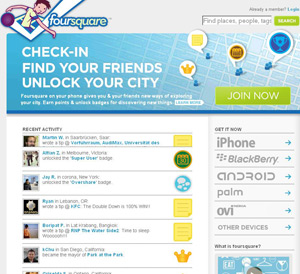 NEW YORK—In
its first report on the use of “geosocial” or location-based services, the
Pew Research Center’s Internet & American Life Project finds that 4 percent of
online adults use a service such as Foursquare or Gowalla that allows them to share their location with friends and to find others who are
nearby. On any given day, 1 percent of internet users are using these services. NEW YORK—In
its first report on the use of “geosocial” or location-based services, the
Pew Research Center’s Internet & American Life Project finds that 4 percent of
online adults use a service such as Foursquare or Gowalla that allows them to share their location with friends and to find others who are
nearby. On any given day, 1 percent of internet users are using these services.
Location-based services such as Foursquare and Gowalla use internet-connected mobile devices’ geolocation capabilities to let users
notify others of their locations by “checking in” to that location. Location-based services often run on stand-alone software applications,
or “apps,” on most major GPS-enabled smartphones or other devices.
The survey's key findings include:
- 7 percent of adults who go online with their mobile phone use a location-based service.
- 8 percent of online adults ages 18-29 use location-based services, significantly more than online adults in any other age group.
- 10 percent of online Hispanics use these services—significantly more than online whites (3 percent) or online blacks (5 percent).
- 6 percent of online men use a location-based service such as Foursquare or Gowalla, compared with 3 percent of online women.
- There are no statistically significant differences by household income or educational attainment.
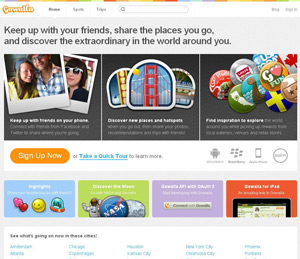 Some
of these “geosocial” services emphasize social networking functions, and can notify friends on the service when the user is
nearby. Users may also be able to leave comments or reviews for a certain business or other location, which may be viewed by later visitors.
Other services take a gaming approach, in which check-ins are used to unlock “levels” or “badges,” or can be used to earn
a certain title (such as “Mayor”) when the user has checked in to that location more than any other user.
(Here the mobile device’s GPS function is also important to help prevent people from checking in to places they are not at
physically, which is considered a form of cheating.) Such detailed real-time information about customers’ habits is very attractive to
businesses, who may share special deals with users, or reward “mayors” and other frequent users with free or
discounted services. Some
of these “geosocial” services emphasize social networking functions, and can notify friends on the service when the user is
nearby. Users may also be able to leave comments or reviews for a certain business or other location, which may be viewed by later visitors.
Other services take a gaming approach, in which check-ins are used to unlock “levels” or “badges,” or can be used to earn
a certain title (such as “Mayor”) when the user has checked in to that location more than any other user.
(Here the mobile device’s GPS function is also important to help prevent people from checking in to places they are not at
physically, which is considered a form of cheating.) Such detailed real-time information about customers’ habits is very attractive to
businesses, who may share special deals with users, or reward “mayors” and other frequent users with free or
discounted services.
Location-based services such as Foursquare or Gowalla are significantly more popular with younger internet users; 8 percent of online adults
ages 18-29 use location-based services, significantly more than online adults in any other age group. Wireless internet users,
unsurprisingly, are also more likely to use location-based services, especially those who connect to the internet with their cell phone.
Seven percent of all adults who go online with their mobile phone say they use a location-based service, as well as 5 percent of all
wireless internet users.
Additionally, the ability to report one’s location is a feature that has recently been added to many pre-existing sites such as
Twitter and Facebook. It is possible that as the lines between different types of services become increasingly blurred, it is difficult
for respondents to always pinpoint exactly what sort of software they are using—especially on their mobile devices. Pew’s recent report on the
rise of apps culture, for instance, found that 11 percent of cell phone owners are not sure whether their phone is even equipped with apps.
This report is based on the results of a telephone survey by the Pew Research Center’s Internet & American Life Project conducted between
Aug. 9 and Sept. 13, 2010. The survey was administered to a sample of 3,001 adults, age 18 and older, using a combination of landline and
cellular telephones. Interviews were conducted in English or Spanish. The sample margin of error is plus or minus 2.5 percentage points
for the general population and plus or minus 2.9 percentage points for internet users (n=2,065).

Using Ning to Amplify Social Networking With Other Groups
By Alan Glazier, OD, FAAO
ROCKVILLE, Md.—Thousands of educators, teachers, professors and nonprofits are using a site
called
Ning. Ning lets people create their own “facebooks” and
enables people to upload photos and videos, participate in discussions, connect with friends, advocate causes, all within a social site
where you control the look, feel and usability. Businesses benefit from the social aspects in Ning to inform customers as they might
with a traditional website.
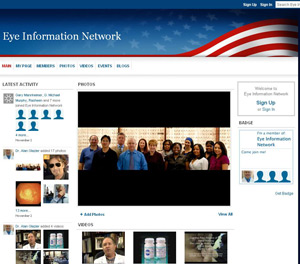 Ning
is described as a branded social destination or digital hub that gives you control over the look, feel and features of a website and really allows
users to create and monetize in a sensible way. Instead of being “forced” into a traditional Facebook template, you have your own
template to use as you’d like. Ning
is described as a branded social destination or digital hub that gives you control over the look, feel and features of a website and really allows
users to create and monetize in a sensible way. Instead of being “forced” into a traditional Facebook template, you have your own
template to use as you’d like.
Ning says they “touch 80 million people globally, every single month”—a sizable network. Their core subscription plan
is $19.95 a month, and that gives you an unlimited number of members and a choice from a huge range of features, from blogs and photos
and events, and everything you need to get started.
I set up Ning recently, a site called Eye Information Network, and am working on building my community. I felt there was an opportunity
in having a custom social media site where I could control the look and feel of my content. I ultimately want it to act as an interactive
“newsletter”—by having patients sign up, so they can participate and not just read about us from the sidelines;
feedback will be a big part of it.
So far, there are a handful of medical professionals using Ning, and many small medical businesses. If Ning sounds like it might be a
good fit for your social marketing efforts, you can visit
Ning and sign up for a month's
free trial. Be sure to connect with my new
Ning Profile when you do.
 Alan N. Glazier, OD, FAAO is the founder/CEO of Shady Grove Eye and Vision Care in Rockville, Md. A search and social optimization
consultant, he is now a regular contributor to CLICK and also writes a regular blog for
SightNation.com.
Glazier is at
aglazier@youreyesite.com and his regular posts can be found via his Twitter
handle: @EyeInfo, his blog:
eyeinfo.wordpress.com and his
website:
YourEyeSite.com. Alan N. Glazier, OD, FAAO is the founder/CEO of Shady Grove Eye and Vision Care in Rockville, Md. A search and social optimization
consultant, he is now a regular contributor to CLICK and also writes a regular blog for
SightNation.com.
Glazier is at
aglazier@youreyesite.com and his regular posts can be found via his Twitter
handle: @EyeInfo, his blog:
eyeinfo.wordpress.com and his
website:
YourEyeSite.com.
|

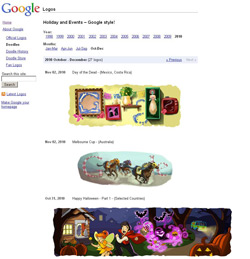
Did you know that Google's “doodles” logos are an international phenomenon? Doodles are the decorative changes that are made
by Google to celebrate holidays, anniversaries, the lives of famous artists and scientists. They often change on the search engine’s
famously-minimal home page. Turns out there’s a location in Google where you can find all of
Google’s doodles. Also on this page, is a link to the details about the
annual Doodle4Google contest where kids in grades K through 12 are invited to work their artistic creativity upon the Google homepage logo.
The 2010 and 2009 winners are posted
here. If you or someone on your
team is feeling creative, Google says, “The doodle team is open to user ideas; requests for doodles
can be sent to
proposals@google.com. The team receives numerous requests so even if we do not get back to you about your request,
please know that we do look at and consider all the requests that are submitted.”


Perhaps you’d like to extend your penmanship and letter-writing into a digital medium? Perhaps you’d like your signature on an e-document
to reflect your real signature? This service site, based in the U.K., offers a range of font-translating software/services, some are
free, some for a premium. They work with mail-merge programs, can be used
for desktop publishing, web design, invitations and more. The site also says it can help people with disabilities by creating a handwritten
style for their communication needs.

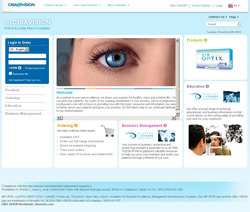
MyCIBAVISION.com
CIBA Vision has re-launched MyCIBAVISION.com, after months of research designed to identify practitioners’ needs and serve their
interests. MyCIBAVISION.com brings all of CIBA Vision’s web-based services and sites together through one portal. Information is organized
on a “dashboard.” Content on MyCIBAVISION.com now falls
under four primary categories: The
Products
section will lead to more in-depth information about the company’s product portfolio; The
Ordering sidebar, which provides direct access to all of the familiar lens ordering systems;
The
Education section which leads to the CIBA Vision ACADEMY FOR EYECARE EXCELLENCE (AECE) which serves education needs through all
stages of practice, and
The Business Management option, which also
connects to the AECE and its proprietary tools designed to help to increase profitability and patient retention.”
Said Rick Weisbarth, OD, FAAO, CIBA Vision’s VP, professional affairs, “Over the course
of the first half of 2011, we will announce more site updates including a private streamlined login function, personalization
options and new interactive features.”

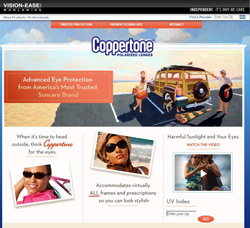
Coppertonelenses.com
In continued support of Coppertone polarized prescription lenses, Vision Ease Lens (VEL) has launched a new consumer website to help people learn
more about the premium protection benefits and proven technology used in these products. Several videos educate consumers on the
importance of sun protection and the dangers of HEV light and UV exposure.
The website includes a provider lookup tool, allowing customers to locate Coppertone prescription sun lens providers in their area.
“The website is a larger platform to not only tell but show the quality of Coppertone lenses,” said Jay Lusignan, marketing
communications manager at VEL. “Our interactive section has many unique features such as the ”see the difference” section
that shows the glare reduction Coppertone lenses provide, as well as a UV Index tool that gives consumers their local UV index.”
|